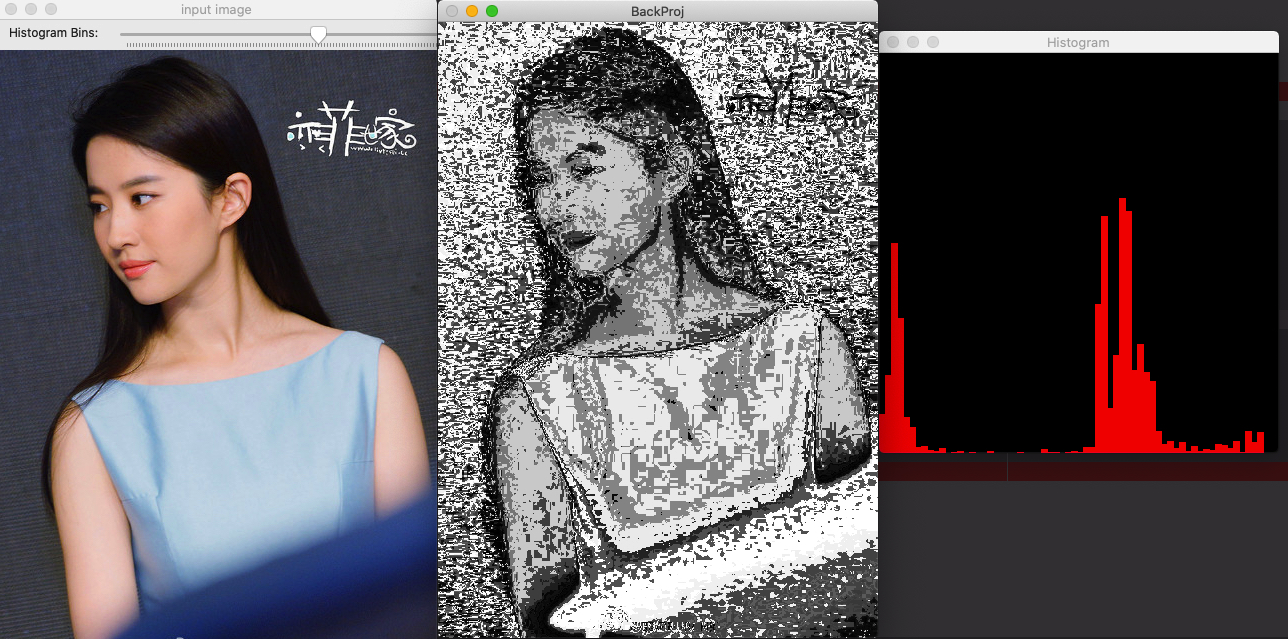1. 相关理论
-
反向投影
- 反向投影是反映直方图模型在目标图像中的分布情况
- 简单点说就是用直方图模型去目标图像中寻找是否有相似的对象。通常用HSV色彩空间的HS两个通道直方图模型
-
反向投影 步骤
- 1.建立直方图模型
- 2.计算待测图像直方图并映射到模型中
- 3.从模型反向计算生成图像
-
实现步骤与相关API
-
加载图片imread
-
将图像从RGB色彩空间转换到HSV色彩空间cvtColor
-
计算直方图和归一化calcHist与normalize
-
Mat与MatND其中Mat表示二维数组,MatND表示三维或者多维数据,此处均可以用Mat表示。
-
计算反向投影图像 -
calcBackProject,一共三个calcBackProject函数,参数不同,利用的是函数重载功能,这里只介绍第一个重载函数void cv::calcBackProject( const Mat * images, int nimages, const int * channels, InputArray hist, OutputArray backProject, const float ** ranges, double scale = 1, bool uniform = true )
以上参数的详细解释:
- images Source arrays. They all should have the same depth, CV_8U, CV_16U or CV_32F , and the same size. Each of them can have an arbitrary number of channels.
- nimages Number of source images.
- channels The list of channels used to compute the back projection. The number of channels must match the histogram dimensionality. The first array channels are numerated from 0 to images[0].channels()-1 , the second array channels are counted from images[0].channels() to images[0].channels() + images[1].channels()-1, and so on.
- hist Input histogram that can be dense or sparse.
- backProject Destination back projection array that is a single-channel array of the same size and depth as images[0] .
- ranges Array of arrays of the histogram bin boundaries in each dimension. See calcHist .
- scale Optional scale factor for the output back projection.
- uniform Flag indicating whether the histogram is uniform or not (see above).
-
2. 源码 & 效果展示
源码:
#include <iostream>
#include <opencv2/opencv.hpp>
#include <opencv2/imgproc/types_c.h>
using namespace std;
using namespace cv;
#ifndef P26
#define P26 26
#endif
#if P27 //直方图反向投影
Mat src; Mat hsv; Mat hue;
int bins = 12;
void Hist_And_Backprojection(int, void*) {
float range[] = { 0, 180 };
const float *histRanges = { range };
Mat h_hist;
calcHist(&hue, 1, 0, Mat(), h_hist, 1, &bins, &histRanges, true, false);
normalize(h_hist, h_hist, 0, 255, NORM_MINMAX, -1, Mat());
Mat backPrjImage;
calcBackProject(&hue, 1, 0, h_hist, backPrjImage, &histRanges, 1, true);
imshow("BackProj", backPrjImage);
int hist_h = 400;
int hist_w = 400;
Mat histImage(hist_w, hist_h, CV_8UC3, Scalar(0, 0, 0));
int bin_w = (hist_w / bins);
for (int i = 1; i < bins; i++) {
rectangle(histImage,
Point((i - 1)*bin_w, (hist_h - cvRound(h_hist.at<float>(i - 1) * (400 / 255)))),
Point(i*bin_w, hist_h),
Scalar(0, 0, 255), -1);
}
imshow("Histogram", histImage);
return;
}
#endif
int main() {
std::string path = "../color_line.JPG";
cv::Mat img = cv::imread(path, 5);
if(img.empty())
{
std::cout << "open file failed" << std::endl;
return -1;
}
#if P26 //直方图反向投影
src = img;
cvtColor(src, hsv, CV_BGR2HSV);
hue.create(hsv.size(), hsv.depth());
int nchannels[] = { 0, 0 };
mixChannels(&hsv, 1, &hue, 1, nchannels, 1);
createTrackbar("Histogram Bins:", str_input, &bins, 180, Hist_And_Backprojection);
Hist_And_Backprojection(0, 0);
imshow(str_input, src);
#endif
cv::waitKey(0);
cv::destroyAllWindows();
return 0;
}
效果展示:

